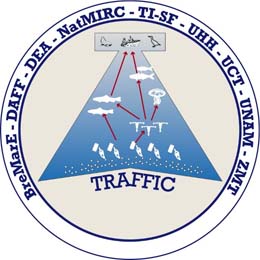Projects
TRAFFIC
investigating Trophic TRAnsfer eFFICiency in the Benguela Current
The overall aim of TRAFFIC is to understand the processes driving the trophic transfer efficiencies in the northern and southern Benguela Upwelling Systems (nBUS, sBUS) and associated feedbacks to fisheries and climate.
Coastal upwelling systems account for about 20% of annual marine fish landings and thus play a significant role not only in the food supply of the world's population but also in the carbon and nutrient turnover in the ocean. The Benguela current upwelling system (BUS) is one of the four highly productive coastal upwelling systems in the world.
However, the high phytoplankton productivity stands in surprising contrast to the low productivity of the higher trophic levels such as fish, seabirds and seals. Despite similar primary production rates, current fish production in the BUS is relatively low, about 10% of the yield in the Humboldt Current. Organisms of higher trophic levels apparently cannot effectively exploit the existing primary production.
Changes in the southeast Atlantic over the last decades have not only changed ecosystem services for the entire BUS, but also led to changes with different consequences in the nBUS and the sBUS (fisheries, CO2 uptake). Hence, despite similar primary production, significant differences of composition and biomass of fish stocks exist between these two subsystems: Fishing yields in the nBUS are significantly lower than in the sBUS, while the composition of fish stock have changed in both subsystems. Besides decreasing fishing yields in the nBUS, the nBUS acts as a significant source of CO2 to the atmosphere, whereas the sBUS acts as a CO2 sink.
Therefore, we aim to understand the reasons for the decrease in fishing yields in the nBUS and the causes of the major changes in the sBUS in order to incorporate these into future sustainable management. A more efficient trophic transfer efficiency is hypothesised to increase fishery yields and CO2 uptake in the sBUS, whereas human induced changes in the pelagic food web structure lowered fishery yields and favoured the CO2 emission in the nBUS. The results will be used to develop a conceptual model of the BUS explaining how changes in ecosystems structure effects fisheries and the biologically mediated CO2 uptake in the two subsystems.
Zooplankton are key organisms in marine food webs transferring energy from primary producers to higher trophic levels. The Marine Zoology working group at the University of Bremen, together with the Leibniz Centre for Marine Tropical Ecosystem Research in Bremen and regional partner institutions in Namibia and South Africa, study the trophic link between primary producers and economically important fish populations. We investigate the pelagic food web structure, trophic interactions and the role of zooplankton in the overall trophic transfer efficiency in the nBUS and sBUS. Since conditions in the nBUS and sBUS deviate, e.g. in terms of zooplankton and commercial fish biomass and community structure, a comparison of these two complex trophic systems will help to understand the functioning of upwelling areas and identify important drivers controlling fish recovery and recruitment, which will be essential for future sustainable fisheries in these areas.

